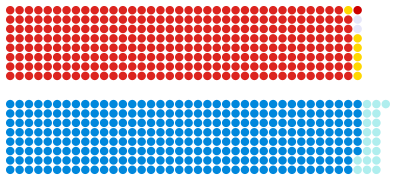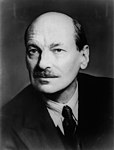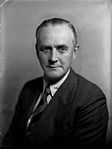1951 United Kingdom general election
| |||||||||||||||||||||||||||||||||||||||||||||
All 625 seats in the House of Commons 313 seats needed for a majority | |||||||||||||||||||||||||||||||||||||||||||||
|---|---|---|---|---|---|---|---|---|---|---|---|---|---|---|---|---|---|---|---|---|---|---|---|---|---|---|---|---|---|---|---|---|---|---|---|---|---|---|---|---|---|---|---|---|---|
| Opinion polls | |||||||||||||||||||||||||||||||||||||||||||||
| Turnout | 82.6%, | ||||||||||||||||||||||||||||||||||||||||||||
| |||||||||||||||||||||||||||||||||||||||||||||
 Colours denote the winning party—as shown in § Results | |||||||||||||||||||||||||||||||||||||||||||||
 Composition of the House of Commons after the election | |||||||||||||||||||||||||||||||||||||||||||||
| |||||||||||||||||||||||||||||||||||||||||||||
The 1951 United Kingdom general election was held twenty months after the 1950 general election, which the Labour Party had won with a slim majority of just five seats. The Labour government called a snap election for Thursday 25 October 1951 in the hope of increasing its parliamentary majority. However, despite winning the popular vote and achieving both the highest-ever total vote until it was surpassed by the Conservative Party in 1992 and again in 2019 and the highest percentage vote share, Labour won fewer seats than the Conservative Party. That was caused mainly by the collapse of the Liberal vote, which enabled the Conservatives to win seats by default. The election marked the return of Winston Churchill as Prime Minister and the beginning of Labour's 13-year spell in opposition. It was the third and final general election to be held during the reign of King George VI, as he died the following year on 6 February and was succeeded by his daughter, Elizabeth II. It was the last election in which the Conservatives did better in Scotland than in England.
The 1951 election was the second one to be covered on BBC Television. On election night, the results were televised from the BBC Alexandra Palace studio in London. Graham Hutton, David Butler and H. G. Nicholas headed the election night coverage from 10.15pm to 4.00am on the television service. On the following day, television coverage started at 10.00am and continued throughout the day until 5.00pm.[1]
Background
King George VI feared since that the government had such a slim majority, and he was to leave the country to go on his planned Commonwealth tour in early 1952, there was a possibility of a change of government in his absence. Clement Attlee decided to call the election to assuage that concern.[2] (In the event, the King became too ill to travel and delegated the tour to his daughter Princess Elizabeth shortly before his death in February 1952). Parliament was dissolved on 5 October 1951.[3]
The Labour government, which had implemented most of its manifesto from the 1945 election, was beginning to lose cabinet ministers, such as Ernest Bevin (death) and Stafford Cripps (health issues). The Conservative Party, however, had more MPs since the 1950 general election.
Campaign
The Labour Party entered the election by being weakened by the emerging schism between
While Labour began to have some policy divisions during the election campaign, the Conservatives ran an efficient campaign, which was well-funded and orchestrated. Their manifesto l, Britain Strong and Free, stressed that safeguarding "our traditional way of life" was integral to the Conservative purpose. Significantly, they did not propose to dismantle the
As for the Liberal Party, its poor election result in 1950 only worsened this time. Unable to get the same insurance against losses of deposits of the previous year, it fielded only 109 candidates, as opposed to 478 in 1950, and thus posted the worst general election result in the party's history by getting just 2.5% of the vote and winning only six seats. The popular vote of the Liberals and later the Liberal Democrats has not fallen so low since, but their lowest number of six seats would be matched in several future elections.[9] The Liberal Party's growing irrelevance weakened the Labour Party since two thirds of potential Liberal voters supported the Conservatives.[4]
Four candidates were returned unopposed, all of them
The subsequent Labour defeat was significant for several reasons. The party polled almost a quarter-million votes more than the Conservative Party and its National Liberal Party ally combined; won the most votes that Labour has ever won (as of 2019); and won the most votes of any political party in any election in British political history, a number that would not be surpassed until the Conservative Party's victory in 1992.
However, the Conservative Party formed the next government with a majority of 17 seats. It performed much better with male working-class voters than in the elections of 1945 or 1950 and tipped the vote away from Labour in
Results

| Candidates | Votes | ||||||||||
|---|---|---|---|---|---|---|---|---|---|---|---|
| Party | Leader | Stood | Elected | Gained | Unseated | Net | % of total | % | No. | Net % | |
| Labour | Clement Attlee | 617 | 295 | 2 | 22 | −20 | 47.2 | 48.8 | 13,948,883 | +2.7 | |
| Conservative | Winston Churchill | 617 | 321 | 23 | 1 | +22 | 51.4 | 48.0 | 13,717,850 | +4.6 | |
| Liberal | Clement Davies | 109 | 6 | 1 | 4 | −3 | 1.0 | 2.6 | 730,546 | −6.5 | |
| Independent Nationalist | N/A | 3 | 2 | 0 | 0 | 0 | 0.3 | 0.3 | 92,787 | N/A | |
Irish Labour
|
William Norton | 1 | 1 | 1 | 0 | +1 | 0.2 | 0.1 | 33,174 | −0.1 | |
| Communist | Harry Pollitt | 10 | 0 | 0 | 0 | 0 | 0.0 | 0.1 | 21,640 | −0.2 | |
| Independent | N/A | 6 | 0 | 0 | 0 | 0 | 0.0 | 0.1 | 19,791 | N/A | |
| Plaid Cymru | Gwynfor Evans | 4 | 0 | 0 | 0 | 0 | 0.0 | 0.0 | 10,920 | −0.1 | |
| SNP | Robert McIntyre | 2 | 0 | 0 | 0 | 0 | 0.0 | 0.0 | 7,299 | 0.0 | |
Ind. Conservative
|
N/A | 1
|
0 | 0 | 0 | 0 | 0.0 | 0.0 | 5,904 | N/A | |
| Ind. Labour Party | Fred Barton | 3 | 0 | 0 | 0 | 0 | 0.0 | 0.0 | 4,057 | 0.0 | |
| British Empire | P. J. Ridout | 1 | 0 | 0 | 0 | 0 | 0.0 | 0.0 | 1,643 | N/A | |
Anti-Partition
|
James McSparran | 1 | 0 | 0 | 0 | 0 | 0.0 | 0.0 | 1,340 | 0.0 | |
| United Socialist | Guy Aldred | 1 | 0 | 0 | 0 | 0 | 0.0 | 0.0 | 411 | 0.0 | |
Total votes cast: 28,596,594.[a]
| Government's new majority | 17 |
| Total votes cast | 28,596,594 |
| Turnout | 82.6% |
Votes summary
Headline swing: 1.13% to Conservative.
Seats summary
Transfers of seats
All comparisons are with the 1950 election.[b]
| From | To | No. | Seats | ||
|---|---|---|---|---|---|
| Labour | Labour (HOLD) | 273 | |||
| Liberal | 1 | Bolton West
| |||
| Conservative | 21 | ||||
| Nationalist | Nationalist (HOLD) | 1 | Fermanagh and South Tyrone | ||
| Independent Nationalist | 1 | Mid Ulster | |||
| Liberal | Labour | 2 | Anglesey, Meirioneth | ||
| Liberal (HOLD) | 5 | Huddersfield West, Montgomery, Orkney and Shetland
| |||
| Conservative | 2 | Roxburgh and Selkirk
| |||
| National Liberal | National Liberal (HOLD) | 16 | Holland with Boston, Huntingdonshire, Luton, Norfolk Central, Renfrewshire West, Ross and Cromarty, St Ives, Torrington
| ||
| Conservative | National Liberal | 1 | Newcastle upon Tyne North
| ||
| Conservative (HOLD) | many | ||||
| Speaker | 1 | Hexham | |||
| Ulster Unionist | Irish Labour
|
1 | Belfast West | ||
| Ulster Unionist | 9 | Down South, Londonderry
| |||
See also
- List of MPs elected in the 1951 United Kingdom general election
- 1951 United Kingdom general election in Northern Ireland
- 1951 Prime Minister's Resignation Honours
Notes
- Ulster Unionists.
- ^ No seats changed hands during the 1950–51 Parliament.
References
- ^ "The General Election". Radio Times (1458): 50. 19 October 1951.
- ^ Judd 2012, p. 238: Judd writes that Attlee confirmed in his own autobiography the King's anxiety.
- ^ "Parliamentary Election Timetables" (PDF) (3rd ed.). House of Commons Library. 25 March 1997. Retrieved 3 July 2022.
- ^ ISBN 978-0-333-56081-5.
- ^ The Times House of Commons 1951, London: The Times Office, 1951, p. 228
- ^ The Times House of Commons 1951, London: The Times Office, 1951, p. 229
- ^ Kynaston 2009, p. 32.
- ^ The Times House of Commons 1951, London: The Times Office, 1951, p. 234
- ^ 1951: Churchill back in power at last, BBC News, 5 April 2005, retrieved 5 October 2013
- ^ "General Election Results 1885–1979". election.demon.co.uk. Archived from the original on 23 February 2008. Retrieved 26 November 2020 – via Wayback Machine.
Sources
- Butler, David E. (1952), The British General Election of 1951, London: Macmillan, The standard study
- ISBN 0900178302
- Judd, Dennis (2012), George VI, I.B. Tauris (paperback), ISBN 978-1-78076-071-1
- ISBN 9780747583851
External links
- United Kingdom election results—summary results 1885–1979
- Churchill & the 1951 General Election - UK Parliament Living Heritage
Manifestos
- Conservative Party: 1951, 1951 Conservative Party manifesto
- Labour Party Election Manifesto, 1951 Labour Party manifesto
- The Nation's Task, 1951 Liberal Party manifesto



